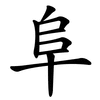阜
| ||||||||
| ||||||||
Translingual
| Stroke order | |||
|---|---|---|---|
 | |||
Alternative forms
- 阝 (when used as a left Chinese Radical)
Han character
阜 (Kangxi radical 170, 阜+0, 8 strokes, cangjie input 竹口十 (HRJ), four-corner 27407, composition ⿱𠂤十)
- Kangxi radical #170, ⾩.
References
- Kangxi Dictionary: page 1345, character 1
- Dai Kanwa Jiten: character 41534
- Dae Jaweon: page 1847, character 25
- Hanyu Da Zidian (first edition): volume 6, page 4114, character 1
- Unihan data for U+961C
Chinese
| simp. and trad. |
阜 | |
|---|---|---|
| alternative forms | 𨸏 峊 | |
Glyph origin
| Historical forms of the character 阜 | ||
|---|---|---|
| Shang | Shuowen Jiezi (compiled in Han) | Liushutong (compiled in Ming) |
| Oracle bone script | Small seal script | Transcribed ancient scripts |
 |
 |
 |
Pictogram (象形) , a row of hills.
Pronunciation
Compounds
Japanese
Readings
Usage notes
- This kanji, when referencing as a radical, is usually called "Gifu-no-'fu'"
Korean
Etymology
From Middle Chinese 阜 (MC bjuwX). Recorded as Middle Korean 부〯 (pwǔ) (Yale: pwu) in Hunmong Jahoe (訓蒙字會 / 훈몽자회), 1527.
Compounds
Compounds
- 대부도 (大阜島, Daebudo, “Daebu Island”)
- 와부읍 (瓦阜邑, Wabueup)
Vietnamese
This article is issued from Wiktionary. The text is licensed under Creative Commons - Attribution - Sharealike. Additional terms may apply for the media files.